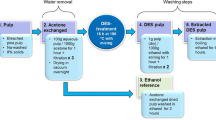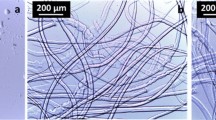Abstract
The effect of urea on the cellulose degradation under conditions of alkaline pulping has been studied using purified cellulose powder. The increased cellulose yield in the presence of urea was assigned essentially to the carbamation reactions which were confirmed by elemental analysis, UV-resonance Raman and solid-state 13C nuclear magnetic resonance spectroscopy. The stabilizing effect of urea on the cellulose peeling reactions during heating up period of pulping process was suggested based on kinetic studies and additionally confirmed in model reactions using cellobiose. The reaction products formed in alkaline urea solutions were analysed by tandem electrospray ionization mass spectrometry and the occurrence of Maillard type reactions between reducing end groups of cellobiose and urea were evidenced. Both Maillard type reactions and carbamation of reducing end groups were proposed to be a part of cellulose protection mechanism against peeling under the conditions of alkaline pulping.








Similar content being viewed by others
References
Bajpai P, Tripathi S, Sharma N, Mishra OP, Bajpai PK (2008) Use of urea as an additive in kraft pulping of eucalyptus. In: TAPPI engineering, pulping and environmental conference, August 24–27, Portland, OR, USA
Benn MH, Jones AS (1960) Glycosylureas. Part I. Preparation and some reactions of d-glucosylureas and d-ribosylureas. J Chem Soc 0:3837–3841
Berthold F, Lindstrom M (1997) Polysulfide addition as a mean to increase delignification in kraft pulping. Nordic Pulp Paper Res 12:230–236
Blain T (1993) Anthraquinone pulping: fifteen years later. Tappi J 76:137–146
Cho NS, Matsumoto Y, Cho HY (2008) Effect of urea addition on soda pulping of oak wood. J Fac Agr Kyushu Univ 53(1):1–5
Clark KG, Gaddy VL, Rist CE (1933) Equilibria in the ammonium carbamate–urea–water system. Ind Eng Chem 25(10):1092–1096
Clayton DW, Marraccini LM (1966) The effect of additives on the stability of polysaccharides in hot alkali. Svensk Papperstidning 69(9):311–321
Ekman K, Eklund V, Fors J, Huttunen J, Mandell L, Selin J-F, Turunen TO (1984) Regenerated cellulose fibers from cellulose carbamate solutions. Lenzinger Berichte 57:38–40
Fleming BI, Kubes GJ, MacLeod JM, Bolker HI (1979) Soda pulping with nitrogenous redox catalysts. Tappi J 62(6):57–59
Furer VL (1990) Carbamate-group conformation and IR band intensities. J Appl Spectrosc 53(2):860–863
Gillaspie AG (1964) Pulping cellulose material with an alkaline cooking liquor containing hydrazine. US Patent 3161562 (published 15 Dez 1964)
Gulsoy SK, Eroglu H (2011) Influence of sodium borohydride on kraft pulping of European black pine as a digester additive. Ind Eng Chem Res 50(4):2441–2444
Haas DW, Hrutfiord BF, Sarkanen KV (1967) Kinetic study on the alkaline degradation of cotton hydrocellulose. J Appl Polym Sci 11–4:587–600
Jiménez L, Rodriguez A, Calero AM, Eugenio ME (2004) Use of ethanolamine-soda-water mixtures for pulping olive wood trimmings. Chem Eng Res Des 82(A8):1037–1042
Johansson MH, Samuelson O (1975) End-wise degradation of hydrocellulose during hot alkali treatment. J Appl Polym Sci 19–11:3007–3013
Klemm D, Heublein B, Fink H-P, Bohn A (2005) Cellulose: fascinating biopolymer and sustainable raw material. Angew Chem Int Ed Engl 44:3358–3393
Kono H, Yunoki S, Shikano T, Fujiwara M, Erata T, Takai M (2002) CP/MAS 13C NMR study of cellulose and cellulose derivatives. 1. Complete assignment of the CP/MAS 13C NMR spectrum of the native cellulose. J Am Chem Soc 124(25):7506–7511
Kotek R (2006) Chapter 10. Regenerated cellulose fibres. In: Lewin M (ed) Handbook of fiber chemistry. Taylor & Francis Group, New York, pp 668–729
Kubes GJ, Fleming BI, MacLeod JM, Bolker HI (1980) Alkaline pulping with additives. A review. Wood Sci Technol 14:207–228
Kumar M, Kumar D (2011) Comparative study of pulping of banana stem. Int J Fiber Text Res 1(1):1–5
Ledl F (1990) Chemical pathways of Maillard reaction. In: Finot PA, Aeschbacher HU, Hurrel RF, Liardon L (eds) The Maillard reaction in food processing, human nutrition and physiology. Birkhäuser, Berlin, pp 19–43
Machell G, Richards GN (1957) The alkaline degradation of polysaccharides. Part II. The alkali-stable residue from the action of sodium hydroxide on cellulose. J Chem Soc 90(6):4500–4506
Nozawa Y, Higashide F (1981) Partially carbamate reaction of cellulose with urea. J Appl Polym Sci 26:2103–2107
Nuessle AC (1961) Some aspects of the reaction between urea and cellulose. Text Res J 31:990–991
Pavasars I, Hagberg J, Boren H, Allard B (2003) Alkaline degradation of cellulose: mechanisms and kinetics. J Polym Environ 11:39–47
Petropavlovskyi G, Zimina T, Grigoriev A (1993) Preparation and properties of cellulose compounds with urea. Zhurnal Prikladnoi Khimii 66(8):1843–1852 (in Russian)
Potthast A, Röhrling J, Rosenau T, Borgards A, Sixta H, Kosma P (2003) A novel method for the determination of carbonyl groups in cellulosics by fluorescence labeling. 3. Monitoring oxidative processes. Biomacromolecules 4:743–749
Röhrling J, Potthast A, Rosenau T, Lange T, Ebner G, Sixta H, Kosma P (2002a) A novel method for the determination of carbonyl groups in cellulosics by fluorescence labeling. 1. Method development. Biomacromolecules 3:959–968
Röhrling J, Potthast A, Rosenau T, Lange T, Borgards A, Sixta H, Kosma P (2002b) A novel method for the determination of carbonyl groups in cellulosics by fluorescence labeling. 2. Validation and application. Biomacromolecules 3:969–975
Roščic M, Versluis C, Kleinnijenhuis AJ, Horvat Š, Heck AJR (2001) The early glycation products of the Maillard reaction: mass spectrometric characterization of novel imidazolidinones derived from an opioid pentapeptide and glucose. Rapid Commun Mass Spectrom 15:1022–1029
Santiago AS, Pascoal Neto C (2007) Review. Assessment of potential approaches to improve Eucalyptus globulus kraft pulping yield. J Chem Technol Biotechnol 82:424–430
Segal L, Eggerton FV (1961) Some aspects of the reaction between urea and cellulose. Text Res J 31:460–471
Suyama K, Sasaki A, Oritani T, Hosono A (2011) Identification of lactose ureide, a urea derivative of lactose, in milk and milk products. J Dairy Sci 94(12):5857–5863
To Vo LT, Široká B, Manian AP, Bechtold T (2010) Functionalisation of cellulosic substrates by a facile solventless method of introducing carbamate groups. Carbohydr Polym 82:1191–1197
Tudella J, Nunes FM, Paradela R, Evtuguin DV, Domingues P, Amado F, Coimbra MA, Barros AIRNA, Domingues MRM (2011) Oxidation of mannosyl oligosaccharides by hydroxyl radicals as assessed by electrospray mass spectrometry. Carbohydr Res 346:2603–2611
Van Loon LR, Glaus MA (1997) Review of the kinetics of alkaline degradation of cellulose in view of its relevance for safety assessment of radioactive waste repositories. J Environ Polym Degrad 5:97–109
Warner RC (1942) The kinetics of the hydrolysis of urea and of arginine. J Biol Chem 142:705–723
Zaia J (2004) Mass spectrometry of oligosaccharides. Mass Spectrom Rev 23:161–227
Zimina T, Petropavlovskyi GA (1994) Preparation and properties of cellulose compounds with urea. Zh Prikl Khim 67(48):636–642
Acknowledgments
Authors acknowledge Portuguese Foundation for Science and Technology (FCT) for the financial support of this work within the scope of CICECO grant PEst-C/CTM/LA0011/2011 and TEKES—the Finnish Funding Agency for Technology and Innovation. The financial support received from Andritz Oy, Danisco Sweeteners Oy, Metsä Fibre Oy, Stora Enso Oy and UPM is also gratefully acknowledged. Authors thank Lidia Testova and Karlo Nieminen from Aalto University (Finland) for their help with kinetic modeling.
Author information
Authors and Affiliations
Corresponding author
Rights and permissions
About this article
Cite this article
Ershova, O., da Costa, E.V., Fernandes, A.J.S. et al. Effect of urea on cellulose degradation under conditions of alkaline pulping. Cellulose 19, 2195–2204 (2012). https://doi.org/10.1007/s10570-012-9791-4
Received:
Accepted:
Published:
Issue Date:
DOI: https://doi.org/10.1007/s10570-012-9791-4




